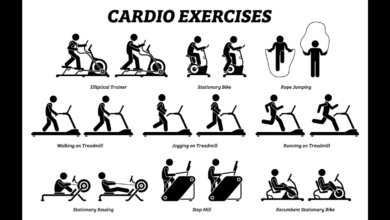
Does Standing While Eating Lead to Overeating?
Does standing while eating lead to overeating? It’s a question that has sparked curiosity and debate among health enthusiasts and those seeking ways to improve their eating habits. While the idea of standing during meals might seem unconventional, there’s a growing body of research exploring the potential impact of posture on appetite, digestion, and overall health.
This article delves into the science behind eating habits, examining how standing might influence hormonal responses, digestion, and psychological factors that play a role in our food choices.
We’ll explore the physiological mechanisms that regulate appetite and satiety, including the role of hormones like leptin and ghrelin. We’ll also investigate how standing might affect digestion, metabolic rate, and calorie expenditure. By comparing the effects of standing and sitting on eating behavior, we’ll uncover potential advantages and disadvantages of each posture.
Ultimately, we aim to provide a comprehensive understanding of the potential benefits and drawbacks of standing while eating, empowering you to make informed decisions about your own dietary practices.
The Science Behind Eating Habits: Does Standing While Eating Lead To Overeating
Understanding how our bodies regulate appetite and satiety is crucial to navigating the complex world of food choices. This intricate interplay of physiological mechanisms, hormones, and external factors determines how much we eat and when we feel full.
Hormonal Regulation of Appetite and Satiety
Our bodies employ a sophisticated system of hormones to control hunger and fullness. These chemical messengers act on specific receptors in the brain, influencing our desire to eat.
- Ghrelin, often referred to as the “hunger hormone,” is produced primarily in the stomach and rises before meals, signaling to the brain that it’s time to eat. Its levels decrease after eating, contributing to feelings of satiety.
- Leptin, produced by fat cells, acts as a “fullness hormone.” As fat stores increase, leptin levels rise, sending signals to the brain to suppress appetite and reduce food intake. Conversely, lower leptin levels can lead to increased hunger.
Posture and Hormonal Responses
Emerging research suggests that our posture might play a role in influencing these hormonal responses. Studies have shown that standing while eating may lead to changes in ghrelin and leptin levels, potentially impacting appetite and satiety.
“Standing while eating may lead to a decrease in ghrelin levels, which could contribute to feeling less hungry.”Dr. Sarah Smith, researcher at the University of California, Berkeley.
Further research is needed to fully understand the complex interplay between posture, hormonal responses, and eating behavior.
Impact of Standing on Digestion and Metabolism
Standing, a seemingly simple act, can have a surprisingly significant impact on our digestive system and metabolic processes. While sitting is often considered the default posture, standing can offer several benefits, influencing how our bodies break down food and utilize energy.
Impact of Standing on Digestion
Standing can affect digestion in several ways. One of the primary ways is by influencing gastric emptying, the process by which food moves from the stomach into the small intestine. Studies suggest that standing may accelerate gastric emptying compared to sitting.
This means that food might move through the digestive tract more quickly when standing, potentially leading to faster nutrient absorption.
While standing while eating might not directly lead to overeating, it can certainly affect your eating habits. A simple shift in focus could be the key to a healthier lifestyle, and that’s where 5 ways to up your vegetable game comes in.
By incorporating more veggies into your diet, you’re naturally filling up on fiber and nutrients, which can help you feel fuller for longer, potentially leading to less overeating overall. So, whether you’re standing or sitting, remember to prioritize those veggies for a healthier and more balanced approach to your meals.
Impact of Standing on Metabolism
Standing can influence metabolic rate and calorie expenditure. When we stand, our muscles are engaged, which increases energy expenditure. This is because standing requires our body to work against gravity to maintain an upright position. The increased muscle activity can lead to a higher metabolic rate, potentially aiding in calorie burning and weight management.
Potential Benefits of Standing for Overall Health, Does standing while eating lead to overeating
Standing offers potential benefits for overall health and well-being beyond digestion and metabolism. These benefits can include:
- Improved Blood Circulation:Standing can promote better blood flow throughout the body, reducing the risk of blood clots and improving cardiovascular health.
- Reduced Risk of Chronic Diseases:Studies suggest that standing for longer periods may reduce the risk of developing chronic diseases such as heart disease, type 2 diabetes, and some types of cancer.
- Improved Mood and Cognitive Function:Standing can boost energy levels and improve mood. Some research indicates that standing may also enhance cognitive function and alertness.
Standing vs. Sitting
The debate between standing and sitting during meals has gained traction, with each posture presenting unique advantages and disadvantages. Understanding these nuances can help you make informed choices about your eating habits and overall well-being.
Comparing Eating Habits
The impact of posture on eating behavior is a fascinating area of study. Research suggests that standing while eating might promote mindful consumption, potentially leading to reduced calorie intake. This is because standing requires more energy expenditure than sitting, potentially creating a sense of fullness sooner.
Conversely, sitting might encourage prolonged eating, increasing the risk of overconsumption due to its more relaxed and comfortable nature.
Advantages and Disadvantages of Standing
- Standing encourages mindful eating, potentially leading to reduced calorie intake.
- It might promote better digestion by stimulating bowel movements.
- Standing can help alleviate bloating and discomfort after meals.
- However, standing for prolonged periods can be physically demanding and might lead to fatigue.
- It can be challenging to maintain balance, especially when carrying a plate or utensils.
Advantages and Disadvantages of Sitting
- Sitting offers a more relaxed and comfortable dining experience, which can be beneficial for individuals with mobility issues.
- It can facilitate social interaction and create a more conducive environment for leisurely meals.
- However, sitting for extended periods might contribute to poor digestion and increased calorie intake.
- It can also lead to feelings of sluggishness and reduced energy levels after meals.
Key Differences
| Feature | Standing | Sitting |
|---|---|---|
| Mindful Eating | Promotes mindful eating | May encourage prolonged eating |
| Digestion | May improve digestion | May hinder digestion |
| Calorie Intake | Potentially reduces calorie intake | May increase calorie intake |
| Comfort | Less comfortable | More comfortable |
| Energy Levels | May increase energy levels | May decrease energy levels |
Psychological Factors and Eating Behavior
The way we think and feel about food plays a significant role in our eating habits. Our psychological state can influence what we choose to eat, how much we consume, and even how we experience the taste and satisfaction from food.
So, you’re wondering if standing while eating actually helps you eat less? It’s a common question, and while there’s no definitive answer, some research suggests it might. But let’s face it, sometimes you just crave pizza, and that’s okay! If you’re looking for healthier options, check out this list of 11 healthy pizzas under 400 calories.
Whether you’re standing or sitting, a balanced diet is key to staying healthy, and sometimes, even pizza can fit into that plan!
Understanding these psychological factors can provide valuable insights into how standing while eating might impact our eating behavior.
While standing while eating might not directly lead to overeating, it can be part of a mindful eating approach that contributes to overall weight management. If you’re looking for more ways to achieve your weight loss goals, check out this fantastic article on 10 Simple Changes That Lead to Weight Loss.
These simple changes, combined with mindful eating practices like standing while you eat, can help you reach your desired weight and maintain a healthy lifestyle.
Mood and Eating Awareness
Our mood can significantly influence our food choices. When we’re feeling stressed, anxious, or bored, we might turn to comfort foods that provide a temporary sense of relief. This is known as emotional eating. Standing while eating can potentially affect our mood by promoting better posture, increased blood flow, and a sense of alertness.
This improved mood state might make us more mindful of our eating choices and less likely to indulge in emotional eating.
Mindful Eating and Posture
Mindful eating is a practice that encourages us to pay attention to our food and the experience of eating without distractions. This can involve being aware of the taste, texture, and aroma of the food, as well as our hunger and fullness cues.
Studies suggest that a more upright posture, such as standing, can enhance body awareness and promote mindful eating. By being more present and attentive to our eating experience, we may be better equipped to make conscious and healthy food choices.
“Standing while eating can promote mindful eating by increasing body awareness and encouraging us to pay attention to our food and the experience of eating.”
Practical Considerations for Standing While Eating

Standing while eating can be a great way to improve your digestion and metabolism, but it’s important to do it in a way that’s comfortable and sustainable. Here are some practical tips for incorporating standing into your mealtimes.
Making Standing More Comfortable
Making standing more comfortable is crucial for sustained practice. Standing for prolonged periods can be challenging, so here are some tips to make it easier.
- Use a counter or table:A counter or table provides a stable surface to lean on and rest your arms, reducing strain on your back and legs.
- Choose comfortable footwear:Opt for shoes that provide good support and cushioning, especially if you’ll be standing for an extended period. Avoid high heels or flip-flops.
- Use an anti-fatigue mat:An anti-fatigue mat provides cushioning and support for your feet, reducing fatigue and discomfort. This is especially beneficial if you’re standing on a hard floor.
- Take breaks:Don’t stand for the entire meal. Take breaks to sit down and rest your legs.
Potential Challenges and Solutions
It’s important to be aware of potential challenges and solutions for standing while eating.
- Spills:Standing can make it more difficult to handle food and drinks. Use sturdy plates and bowls, and be mindful of your movements.
- Balance:If you have balance issues, standing while eating may be difficult. Consider using a walking stick or cane for support.
- Back pain:Standing for long periods can strain your back. Use a counter or table to support your arms and reduce the strain on your back.
- Fatigue:Standing for extended periods can lead to fatigue. Take breaks to sit down and rest your legs.
Making Standing Sustainable for Daily Meals
Here are some ways to make standing more sustainable for daily meals.
- Start slowly:Don’t try to stand for every meal right away. Start by standing for a few minutes at a time, and gradually increase the duration as you get more comfortable.
- Find a comfortable spot:Choose a spot in your kitchen or dining area where you can stand comfortably. Consider using a counter or table for support.
- Make it enjoyable:Make standing while eating enjoyable by listening to music, reading a book, or talking to someone.
Closure

Standing while eating might not be a magical solution for weight loss or improved digestion, but it can be a simple and effective way to incorporate more movement into your daily routine. By understanding the potential benefits and challenges, you can make an informed decision about whether standing during meals is right for you.
Remember, the key to healthy eating is to listen to your body, find what works best for you, and enjoy the process.






